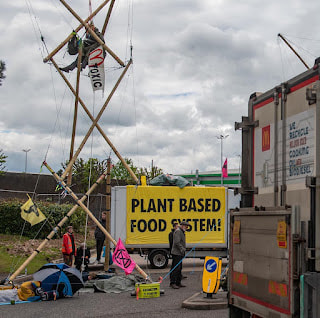 Firms are often targeted by social movements seeking to reform their behaviors. Think of the environmental destruction from fast-food packaging, the climate change driven by carbon emissions, and the wildlife reserves threatened by land development or mining. Often a single firm will attract attention from multiple social movement organizations that all want to change the same thing it is doing—such as air pollution—and its decision-makers may try to engage in discussions with them to find effective solutions. Will such engagement be possible, and if so, which social movement organizations will collaborate with the firm? As Kate Odziemkowska demonstrates in research published by Administrative Science Quarterly, the answer lies in networks. If you read this earlier blog post and the one before, you have become used to networks being the answer to many questions, but this time you may wonder what kind of networks are in action. The answer is surprising but intuitive once you consider it: Because each social movement organization is fueled by its membership’s devotion to its cause, and some are more radical than others, what matters is the network of connections between the very radical social movement organizations and the moderate ones. How does this work? First, firms prefer to collaborate with moderates, and moderate social movement organizations are much more likely than radicals to collaborate with firms. Second, social movement organizations collaborate with each other before they collaborate with firms, but moderates and radicals collaborate only in some social movements, not all. The effects of this collaboration (or lack of it) may seem counterintuitive: Moderates who collaborate with radicals in the social movement are more likely to work with firms, while moderates operating in a social movement where collaboration with radical groups does not happen are much less likely to work with firms. In the latter situation, moderates may fear that collaborating with firms will destroy their relationships and audience support within the social movement. Moderates connected to radicals are thus able to discuss, while moderates who lack that connection must shout in order to maintain their credibility in the movement. What about the firm’s willingness to have discussions with social movement organizations? That part of the story is much simpler. To start, firms generally prefer to change nothing, especially along the dimensions of environmental and social responsibility that movements typically target. That is exactly why social movements target firms. Once they have been targeted by a social movement, firms do in fact seek collaborations. And they are interested in neutralizing the entire social movement, not just the social movement organization they start collaborating with, so for firms, it may be better to have discussions with moderate social movement organizations that are connected to radicals. This tactic is riskier for the social movement organization than for the firm, because radical social movement organizations may be critical of the collaboration. This research brings up an interesting dilemma facing social movement organizations. To fulfill their goal of changing firm behaviors, they should engage in discussions with the firms and collaborate to find the best way forward. But many social movement organizations are built on the anger of their members, so talking to “the enemy” can weaken the movement. They need to have the strength to weaken themselves for the sake of fulfilling their goals. Odziemkowska, Kate. 2021. Frenemies: Overcoming Audiences’ Ideological Opposition to Firm–Activist Collaborations. Administrative Science Quarterly, forthcoming. Comments are closed.
|
Blog's objectiveThis blog is devoted to discussions of how events in the news illustrate organizational research and can be explained by organizational theory. It is only updated when I have time to spare. Archives
January 2024
Categories |
 RSS Feed
RSS Feed